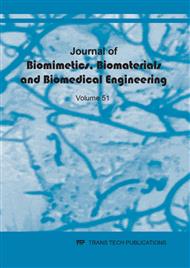[1]
A. Hariprasad, V. Kundapur, H. S. Mohammed, M. Anand, G. S. Amarnath, A review on biomaterials in dental implantology,, International journal of biomedical science: IJBS 11.3 (2015), pp.113-120.
Google Scholar
[2]
M. D. Fabbro, C. M. Bellini, D. Romeo, L. Francetti, Tilted implants for the rehabilitation of edentulous jaws: a systematic review,, Clinical implant dentistry and related research 14.4 (2012), pp.612-621.
DOI: 10.1111/j.1708-8208.2010.00288.x
Google Scholar
[3]
T. H. Lan, J. K. Du, C. Y. Pan, H. E. Lee, W. H. Chung, Biomechanical analysis of alveolar bone stress around implants with different thread designs and pitches in the mandibular molar area,,, Clinical oral investigations 16.2 (2012), pp.363-369.
DOI: 10.1007/s00784-011-0517-z
Google Scholar
[4]
M.W. Klotz, T.D. Taylor, A.J. Goldberg, Wear at the titanium-zirconia implant-abutment interface: a pilot study,, The International journal of oral & maxillofacial implants 26.5 (2011), pp.970-975.
Google Scholar
[5]
P. Gehrke, J. Alius, C. Fischer, K. J. Erdwlt, F. Beuer, Retentive strength of two‐piece CAD/CAM zirconia implant abutments,, Clinical implant dentistry and related research 16.6 (2014), pp.920-925.
DOI: 10.1111/cid.12060
Google Scholar
[6]
J. Torsten, Data on implant failures will show different results depending on how patients are compiled and analyzed: A retrospective study on 3902 individual patients treated either with one single implant or implants in the edentulous upper jaw,, Clinical Implant Dentistry and Related Research 22.2 (2020), pp.226-236.
DOI: 10.1111/cid.12886
Google Scholar
[7]
S. Roehling, M. Astasov-Frauenhoffer, I. Hauser-Gerspach, O. Braissant, H. Woelfler, In vitro biofilm formation on titanium and zirconia implant surfaces,, Journal of periodontology 88.3 (2017), pp.298-307.
DOI: 10.1902/jop.2016.160245
Google Scholar
[8]
P. Van de Heyning, M. Atlas, W. D. Baumgartner, M. Caversaccio, J. Gavilan, B. Godey, W. Gstottner, R. Hagen, L. Yongxin, E. Karltorp. M. Kameswaran, The reliability of hearing implants: report on the type and incidence of cochlear implant failures,, Cochlear Implants International (2020), pp.1-10.
DOI: 10.1080/14670100.2020.1735678
Google Scholar
[9]
E.S. Kim, S.Y. Shin, Influence of the implant abutment types and the dynamic loading on initial screw loosening,, journal of advanced prosthodontics 5.1 (2013), pp.21-28.
DOI: 10.4047/jap.2013.5.1.21
Google Scholar
[10]
M. Stimmelmayr, D. Edelhoff, J. F. Guth, K. Erdelt, A. Happe, F. Beuer, Wear at the titanium–titanium and the titanium–zirconia implant–abutment interface: A comparative in vitro study,, Dental Materials 28.12 (2012), pp.1215-1220.
DOI: 10.1016/j.dental.2012.08.008
Google Scholar
[11]
C.D. Nascimento, M.S. Pita, F.H.N.C. Fernandes, V. Pedrazzi, R.F.A. Junior, R.F. Ribeiro, Bacterial adhesion on the titanium and zirconia abutment surfaces,, Clinical oral implants research 25.3 (2014), pp.337-343.
DOI: 10.1111/clr.12093
Google Scholar
[12]
R. S. Boggan, J. T. Strong, C. E. Misch, M. W. Bides, Influence of hex geometry and prosthetic table width on static and fatigue strength of dental implants., The Journal of prosthetic dentistry 82.4 (1999), pp.436-440.
DOI: 10.1016/s0022-3913(99)70030-2
Google Scholar
[13]
O. Kayabaşı, E. Yüzbasıoğlu, F. Erzincanli Static, dynamic and fatigue behaviors of dental implant using finite element method,, Advances in engineering software 37.10 (2006), pp.649-658.
DOI: 10.1016/j.advengsoft.2006.02.004
Google Scholar
[14]
L. Steinebrunner, S. Wolfart, K. Ludwig, M. Kern Implant–abutment interface design affects fatigue and fracture strength of implants., Clinical Oral Implants Research 19.12 (2008), pp.1276-1284.
DOI: 10.1111/j.1600-0501.2008.01581.x
Google Scholar
[15]
A. Khraisat, R. Stegaroiu, S. Nomura, O. Miyakawa, Fatigue resistance of two implant/abutment joint designs,, The Journal of prosthetic dentistry 88.6 (2002), pp.604-610.
DOI: 10.1067/mpr.2002.129384
Google Scholar
[16]
M. Prados-Privado, J.C. Prados-Frutos, J.L. Calvo-Guirado, J.A. Bea, A random fatigue of mechanize titanium abutment studied with Markoff chain and stochastic finite element formulation,, Computer Methods in Biomechanics and Biomedical Engineering 19.15 (2016): pp.1583-1591.
DOI: 10.1080/10255842.2016.1170124
Google Scholar
[17]
A. Swamy, B.S. Shenoy, I. N. Aparna, Effect of grid size on fatigue life calculations of a dental implant,, Journal of Computational Methods in Sciences and Engineering 17.2 (2017), pp.289-293.
DOI: 10.3233/jcm-170710
Google Scholar
[18]
Y.C. Cheng, C. P. Jiang, D. H. Lin, Finite element based optimization design for a one-piece zirconia ceramic dental implant under dynamic loading and fatigue life validation,, Structural and Multidisciplinary Optimization 59.3 (2019), pp.835-849.
DOI: 10.1007/s00158-018-2104-2
Google Scholar
[19]
A. Boukhlif, A. Merdji, S. Roy, H. Alkhaldi, I. Abu-Alshaikh, N. Della, C. M. Cristache, R. Hillstrom, Effect of supporting implants inclination on stability of fixed partial denture: A finite element study. Proceedings of the Institution of Mechanical Engineers, Part H,, Journal of Engineering in Medicine, 234(10), (2020), pp.1162-1171.
DOI: 10.1177/0954411920944109
Google Scholar
[20]
Y. Gupta, R. Iyer, V. K. Dommeti, E. Nutu, M. Rana, A. Merdji, J. K. Biswas, S. Roy, "Design of dental implant using design of experiment and topology optimization: A finite element analysis study. Proceedings of the Institution of Mechanical Engineers, Part H: Journal of Engineering in Medicine, (2020).
DOI: 10.1177/0954411920967146
Google Scholar
[21]
V. Jain, V. K. Dommeti, E. Nutu, A. Merdji, J. K. Biswas, S. Roy, August. Mechanical response of taper dental implants using finite element analysis,, In IOP Conference Series: Materials Science and Engineering, Vol. 912, No. 2, (2020).
DOI: 10.1088/1757-899x/912/2/022052
Google Scholar
[22]
A. Eser, T. Albrecht, S. Heintze, FEM Simulations of ISO 14801 Implant Fatigue Test Setup., Conference Paper, (2018).
Google Scholar
[23]
F. Bayata, C. Yildiz, The effects of design parameters on mechanical failure of Ti-6Al-4V implants using finite element analysis,, Engineering Failure Analysis, 110 (2020).
DOI: 10.1016/j.engfailanal.2020.104445
Google Scholar
[24]
Y. Luo, L. Yang, M. Tian, Application of biomedical-grade titanium alloys in trabecular bone and artificial joints,, In Biomaterials and Medical Tribology, Woodhead Publishing, (2013), pp.181-216.
DOI: 10.1533/9780857092205.181
Google Scholar
[25]
M. Prados-Privado, S. A. Gehrke, R. Rojo, J. C. Prados-Frutos, Complete mechanical characterization of an external hexagonal implant connection: in vitro study, 3D FEM, and probabilistic fatigue,, Medical & biological engineering & computing, 56(12), (2018), pp.2233-2244.
DOI: 10.1007/s11517-018-1846-8
Google Scholar


